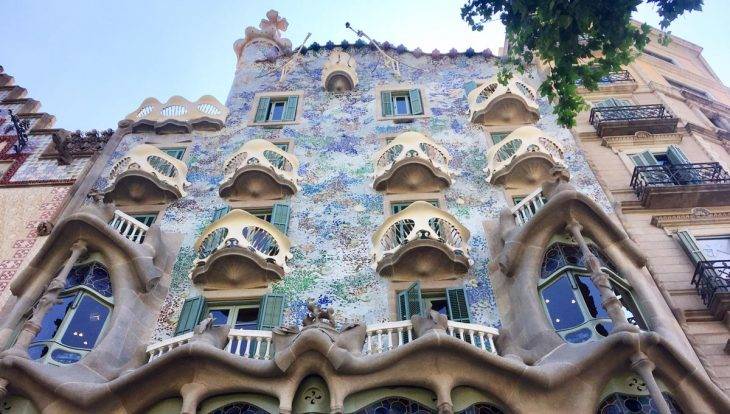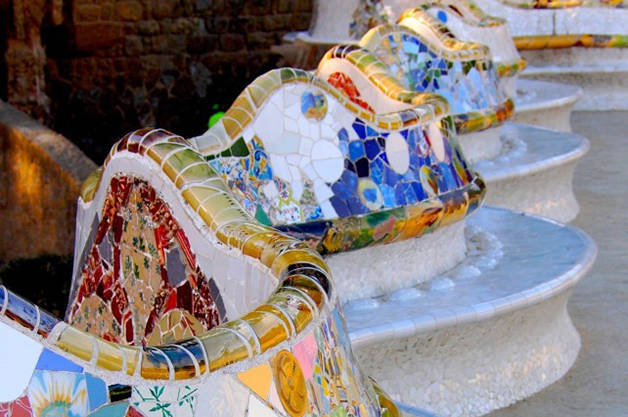Gaudí and Barcelona: architectural masterpieces in the city

You can’t think of Barcelona without thinking of Antoni Gaudí, whose work seems to form part of the city’s DNA. The Catalan architect devoted his life to his works, which are harmonious combinations of art, convictions and beliefs.
Gaudí was born in Reus, to the south-west of Barcelona, in 1852. From a relatively humble background, he studied at the Llotja school and graduated in 1878.
At the graduation ceremony, the director of the establishment is said to have remarked: “We’ve awarded this degree to either a madman or a genius. Only time will tell”.
Gaudí’s inspirations
Gaudí had his own, very personal style, and is considered to be the main proponent of Catalan modernism. His main sources of inspiration included religion, nature and Catalonia itself.
Casa Vicens
This was Gaudí’s first major work, ordered by Manuel Vicens Montaner in 1878, when the newly-qualified architect was just 26 years old. Construction went on for ten years.
The very simple structure of the house contrasts sharply with its complex volumes and its decoration, which has a strong Moorish feel.
Located in the Gràcia quarter (métro: Fontana, L3) Casa Vicens opened in November! Now you can admire it also from the inside!
Casa Batlló

Gaudí was 52 when he began work on the renovation of Casa Batlló, bought in 1903 par Josep Batlló.
The structure is noted for its façade, a harmonious combination of different textures, materials, volumes and colours.
The roof is intended to represent a dragon, whilst the balustrades take the form of masks. The wave-like forms and blue tones are inspired by seascapes and by natural scenery, giving a unique dynamic to the construction.
Gaudí paid particular attention to the terrace, creating a whole universe of shapes and colours, with wacky, blue-toned chimneys, making something decorative out of an essentially functional area.
- Attention! Tickets cost €4 more at the ticket office.
- Our advice? Book your tickets in advance to save money and time!
La Pedrera

At its creation, this was the most polemical of Gaudí’s work; for certain experts, however, La Pedrera marks the culmination of the architect’s personal style.
The stone-covered façade absorbs light and represents the movement of the sea.
The terrace features immense sculptures, some over 7.8 metres high: these are, in fact, the building’s chimneys and air ducts, transformed into decorative elements with more than a touch of the medieval knight about them.
- Attention! Tickets cost €3 more at the ticket office.
- Our advice? Book your tickets in advance to save money and time!
Sagrada Familia: Gaudí’s magnum opus
Sagrada Familia (Holy Family) is Barcelona’s most-visited monument. The project was launched in 1872 by a Barcelonian bookshop owner, Josep Maria Bocabella.
Work was begun under the direction of Francesc de Paula Villar, but he abandoned the project, which was then given to Gaudí in 1883, when the architect was 31. Gaudí’s aim was to create the perfect church, including all of the symbolic elements of Christianity; he devoted 43 years of his life to the project.
- Intrigued? See our article on Sagrada Familia for more information.
Parc Güell
Parc Güell was the brainchild of the industrialist and politician Eusebi Güell, who commissioned Gaudí to work on the project in 1900. His aim was to create an ideal residential quarter, combining both Catalan and Christian symbolism.
However, work came to a halt in 1914, and only two of the planned 60 houses were built.
In 1922, the site came into the hands of the city and was designated as a public park. In 1984, Parc Güell was added to the list of Unesco World Heritage sites.
Gaudí designed the entrance as a set of clues, intended to signify “Parc Güell is paradise”: a paradise of coloursm, shapes, volumes and materials, separated from the earth by the immense gate at the main entrance.
- Don’t miss our article on this truly unique park.
Our thanks to Guillermo for allowing us to use his beautiful photographs of Casa Batlló and of the interior of Sagrada Familia.





